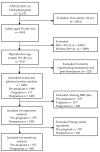The Profiling of Diet and Physical Activity in Reproductive Age Women and Their Association with Body Mass Index
- PMID: 35807789
- PMCID: PMC9268133
- DOI: 10.3390/nu14132607
The Profiling of Diet and Physical Activity in Reproductive Age Women and Their Association with Body Mass Index
Abstract
Pre-pregnancy, pregnancy and postpartum are critical life stages associated with higher weight gain and obesity risk. Among these women, the sociodemographic groups at highest risk for suboptimal lifestyle behaviours and core lifestyle components associated with excess adiposity are unclear. This study sought to identify subgroups of women meeting diet/physical activity (PA) recommendations in relation to sociodemographics and assess diet/PA components associated with body mass index (BMI) across these life stages. Cross-sectional data (Australian National Nutrition and Physical Activity Survey 2011-2012) were analysed for pre-pregnancy, pregnant and postpartum women. The majority (63-95%) of women did not meet dietary or PA recommendations at all life stages. Core and discretionary food intake differed by sociodemographic factors. In pre-pregnant women, BMI was inversely associated with higher whole grain intake (β = -1.58, 95% CI -2.96, -0.21; p = 0.025) and energy from alcohol (β = -0.08, -0.14, -0.005; p = 0.035). In postpartum women, BMI was inversely associated with increased fibre (β = -0.06, 95% CI -0.11, -0.004; p = 0.034) and PA (β = -0.002, 95% CI -0.004, -0.001; p = 0.013). This highlights the need for targeting whole grains, fibre and PA to prevent obesity across life stages, addressing those most socioeconomically disadvantaged.
Keywords: body mass index; diet; dietary guideline; physical activity; reproductive age women.
Conflict of interest statement
The authors declare no conflict of interest.
Figures



Similar articles
-
The effect of weight management interventions that include a diet component on weight-related outcomes in pregnant and postpartum women: a systematic review protocol.JBI Database System Rev Implement Rep. 2015 Jan;13(1):88-98. doi: 10.11124/jbisrir-2015-1812. JBI Database System Rev Implement Rep. 2015. PMID: 26447010
-
Modeling the effect of diet and physical activity on body mass index in prepregnant and postpartum women.Nutrition. 2023 Jul;111:112026. doi: 10.1016/j.nut.2023.112026. Epub 2023 Mar 7. Nutrition. 2023. PMID: 37062079
-
The contribution of diet, physical activity and sedentary behaviour to body mass index in women with and without polycystic ovary syndrome.Hum Reprod. 2013 Aug;28(8):2276-83. doi: 10.1093/humrep/det256. Epub 2013 Jun 15. Hum Reprod. 2013. PMID: 23771201
-
The Relationship of Diet and Physical Activity with Weight Gain and Weight Gain Prevention in Women of Reproductive Age.J Clin Med. 2021 Jun 4;10(11):2485. doi: 10.3390/jcm10112485. J Clin Med. 2021. PMID: 34199753 Free PMC article. Review.
-
Offspring body size and metabolic profile - effects of lifestyle intervention in obese pregnant women.Dan Med J. 2014 Jul;61(7):B4893. Dan Med J. 2014. PMID: 25123127 Review.
Cited by
-
Dietary intakes, diet quality and physical activity levels from preconception to late pregnancy: Prospective assessment of changes and adherence to recommendations.Womens Health (Lond). 2025 Jan-Dec;21:17455057251341999. doi: 10.1177/17455057251341999. Epub 2025 Jun 24. Womens Health (Lond). 2025. PMID: 40554727 Free PMC article.
-
Association Between Nutritional Status and Physical Activity Among Reproductive Age Women in Arba Minch Health and Demographic Surveillance Site, Southern Ethiopia.Int J Public Health. 2025 Mar 26;70:1608161. doi: 10.3389/ijph.2025.1608161. eCollection 2025. Int J Public Health. 2025. PMID: 40206456 Free PMC article.
-
Assessing the influence of preconception diet on female fertility: a systematic scoping review of observational studies.Hum Reprod Update. 2023 Nov 2;29(6):811-828. doi: 10.1093/humupd/dmad018. Hum Reprod Update. 2023. PMID: 37467045 Free PMC article.
-
Is lifestyle Modification the Key to Counter Chronic Diseases?Nutrients. 2022 Jul 22;14(15):3007. doi: 10.3390/nu14153007. Nutrients. 2022. PMID: 35893860 Free PMC article.
-
Comparison of two methods of measuring physical activity and its related components among middle age women: Pedometer versus self-report.PLoS One. 2025 Feb 26;20(2):e0319288. doi: 10.1371/journal.pone.0319288. eCollection 2025. PLoS One. 2025. PMID: 40009599 Free PMC article. Clinical Trial.
References
-
- National Research Council. Institute of Medicine . Weight Gain during Pregnancy: Reexamining the Guidelines. National Academies Press; Washington, DC, USA: 2010. - PubMed
-
- Goldstein R.F., Abell S.K., Ranasinha S., Misso M.L., Boyle J.A., Harrison C.L., Black M.H., Li N., Hu G., Corrado F. Gestational weight gain across continents and ethnicity: Systematic review and meta-analysis of maternal and infant outcomes in more than one million women. BMC Med. 2018;16:153. doi: 10.1186/s12916-018-1128-1. - DOI - PMC - PubMed
MeSH terms
Substances
LinkOut - more resources
Full Text Sources
Medical

